Popular Uses of Elfin Thyme
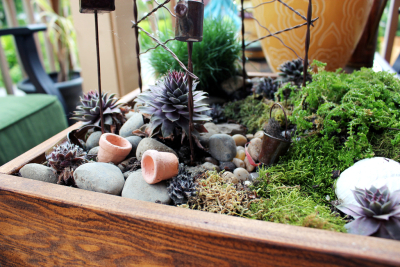
As already mentioned, creeping thyme has become a popular choice for fairy gardens like the one shown here from the inspired room. The two species of thyme most often referred to as Elfin Thyme are Thymus serpyllum and Thymus praecox. There are several varieties of both as well as a number of other species being sold to Fairy Gardeners due to their small size and pretty little flowers.
Traditionally, creeping thyme has been used as an evergreen ground-cover and often used in rock gardens and in between stepping stones. It is a “stepable” – meaning that it can be used in an area of the garden that receives moderate foot traffic.
From everything I’ve read, the creeping thymes are edible but they vary greatly in their culinary usefulness. Their scent, and one would therefore presume their flavor, varies with the seasons and the climate of where it is being grown. If you plan on harvesting leaves for drying, the best times are early and late summer; right before the flowers bloom.
Growing Creeping Thyme
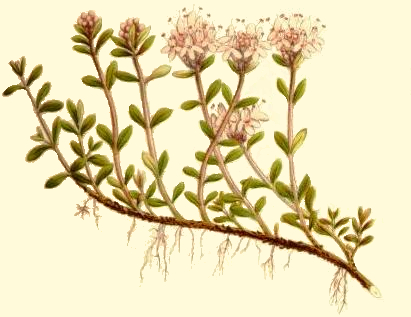
All of the species of thyme currently being sold as creeping or elfin thyme require similar soil conditions. They prefer dry to medium, well-drained soil. All thyme tends to rot in moist or wet soil particularly during the winter months. (Actually, the leaves will all turn black and the plant will die a slow and lingering death if you over-water. Just ask me. I know.)
Thyme is. however, fairly good drought tolerant. One source suggested a thin layer of gravel be placed around the plant to help protect the foliage from wet soil.
They are considered deer tolerant but as we all know that seems to depend on what your resident critters might deem tasty as opposed to what the experts say. I did notice a site from England mentioned a number of species as being “noted for attracting wildlife” but it wasn’t clear if that meant bees and butterflies or something that would make a meal out of your thyme plants.
I’ve seen varying reports on where these plants do best. Most species of creeping thyme seem safe for anyone in Zones 5-8 but there are a few requiring warmer temperatures or that can handle slightly more cold. They originally grew wild in the more temperate areas of Europe and a few species have become naturalized in the American northwest to the point of becoming invasive.
Though only discussed on one of my sources, it would seem that most species and varieties of creeping thyme are considered “cultivars” and while some can be grown from seed, they are not thought to remain true. They suggested propagation by cutting and division to retain the characteristics of the parent plant. Spring and early fall are the suggested times for dividing the creeping thymes. However, divisions may not stand up to a late spring or early fall frost. Starting plants from seed is possible but the germination rates are somewhat low.
Additionally, thyme is generally a slow-growing herb which makes these smaller species and varieties even a more popular choice for miniature gardens.
Creeping Thyme Varieties
While the plants being sold as creeping thyme or elfin thyme are quite similar in growth habit and produce lovely little flowers, it might be helpful to know which is which before investing in one or more of these charming herbal plants.
Perhaps due to their ability to hybridize, it would seem even the experts have some trouble determining which plants belong categorized under which species. I found a number of sites (some by botanical gardens and universities) that seem to use wild thyme and mother-of-thyme as the common name for a number of different species. I also noticed some of the details of the plants’ growing habits can vary between sources. Making it even more interesting is that several varieties of creeping thyme smell, and even taste, like other herbs. The good news is that most creeping thyme generally requires the same growing conditions but the color of the flowers and the overall size of the plant can vary. Your best bet might be to wait until the plants are flowering to make your purchase if the color of your Elfin thyme truly matters to you.
Thymus serpyllum
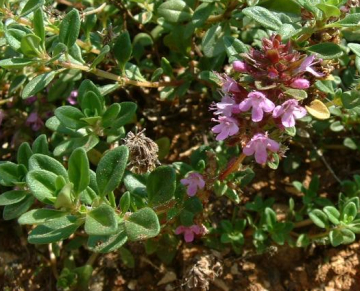
Thymus serpyllum is also known by the names Breckland thyme, mother-of-thyme, wild thyme, mauve creeping thyme, pink chintz or creeping thyme. Of the two varieties of creeping thyme generally sold as Elfin, serpyllym has the brighter colored flowers which are generally lilac to purple or pink.
Serphyllum blooms between July and August. Several sources mentioned it does well into USDA Hardiness Zone 4 (winter temperatures 1 or 2 degrees within freezing). Plants rarely exceed 3 inches tall and the leaves are generally .2 to .3 inches (about the thickness of 5 dimes).
Thymus serphyllum grows wild in the rocky soils of southern Europe and North Africa. While all thymes are known for being good nectar sources, serphyllum is an important nectar source for honeybees. Wild thyme honey is a delicacy in Greece.
You can purchase 5,000 Seeds, of Creeping Thyme (Thymus serpyllum) from Amazon.com. (Keep in mind these are slow-growing plants that tend to have a low germination rate. A number of people reported a 50% germination rate which seems great for something not generally recommended to grow from seed.)
Thymus praecox
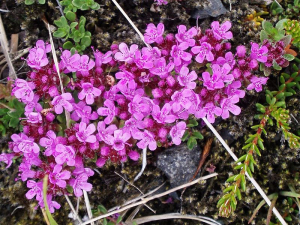
Thymus praecox is listed as usable for cooking. However, with a scent more similar to oregano, it might not provide the flavor you would expect.
Praecox has a number of subspecies and cultivars. It is slightly less cold-tolerant than serphyllum but blooms from June to September. The flowers are generally purplish white.
“Pink Chintz” was originally classified as a subspecies of thymus praecox but has since been reclassified as Thymus serphyllum ‘Pink Chintz’. I would suspect this species may be found in stores under all three names, I guess the one to look for is “Pink Chintz” as that is the only part of the name that hasn’t changed.
Pink Chintz
Pink Chintz has salmon-pink flowers and blooms in early spring. It has fuzzy leaves and only grows 1-2 inches tall (it’s the lowest growing of the widely used thymes) and can spread to 18 inches wide. Not only is it one of the earliest blooming thymes, Pink Chintz may be the most drought tolerant.
One grower suggested shearing the plant down to half an inch and after it flowers, trimming it lightly back to get rid of spent blooms and maintain a neat appearance.
Wooly Thyme
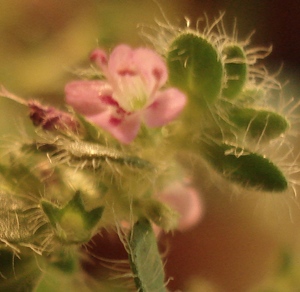
Formerly known as Thymus lanuginosus but now classified as a praecox subspecies, wooly thyme is now called thymus pseudolanuginosus or thymus praecox subsp. britannicus. It is just one of several species of creeping thymes that possesses hairy or wooly leaves.
It is native to southern Europe and generally grows only 3 inches tall but my sources have it spreading anywhere from 12 inches to over 3 feet. It has pale pink flowers that bloom from June to July but is hardy only to Zone 6. The plant I had did not grow very far off of the ground – think short-piled carpet. The flowers formed along the branch and did not send up ‘flower spikes.’
It is officially listed as being able to grow in Zones 5-8 but it might prefer a protected location when planted in Zone 5.
Wooly thyme appears to be the least fragrant and suitable for culinary uses among the creeping thymes.
Caraway Thyme
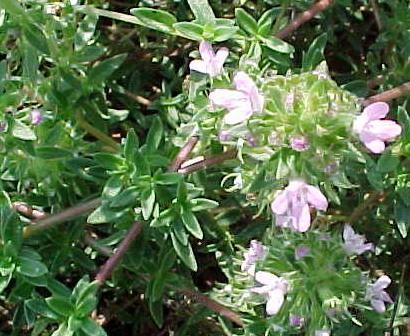
Caraway thyme is a species of thyme that has a strong caraway scent. It’s real name is Thymus herba-barona and is native to Corsica, Sardinia, and Majorca. This species of creeping thyme can actually be used as a substitute for caraway. You might also notice that the leaves of this plant are a bit more elongated than the other varieties of creeping thyme. Depending upon the size of your fairy garden, caraway thyme may not offer that “elfin” look that so many desire.
The flowers are a pale lavender. It grows to about 4 inches tall and spreads about 12.
Caraway thyme has been traditionally used as a seasoning for barons of beef in England which is the source of inspiration for its scientific name. It is also used with soups and vegetables and is said to compliment garlic well.
Thymus caespititius
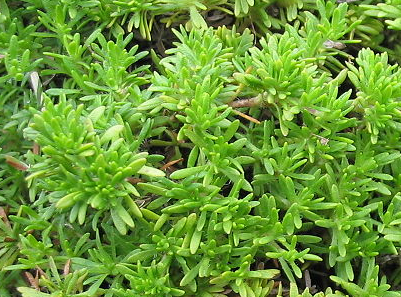
Thymus caespititius or Cretan Thyme is another low-growing, creeping thyme. It grows up to 4 inches tall and 1 foot wide. It is far less cold-tolerant than many of the other varieties being a native of Portugal, northwest Spain and the Azores. There was a bit of conflict on how hardy this plant is. One source listed it as safe in Zone 7 (a UK site) and Wikipedia listed it as being hardy only in Zones 9-11.
Cretan thyme flowers from July to August with flowers that range in color from rose or lilac to white. The leaves smell a bit like tangerines and are considered quite edible.
Lemon Thyme
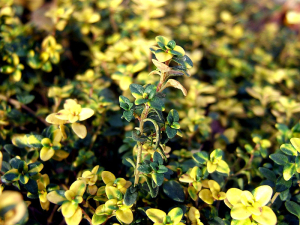
Lemon thyme or Thymus x citriodorus is perhaps the most edible of all of the creeping thyme species we’ve discussed. The leaves are generally eaten raw and are prized for their delicious lemon flavor. It is hardy only to Zone 7, does not like the shade and can tolerate fairly strong winds. Lemon thyme grows to an average height of 4 inches and spreads to about 12. The flowers range from a bright yellow to the more commonly occurring shades of pink and purple. The flowers bloom from July to August.
It is believed that lemon thyme is actually its own species rather than a hybrid or cross. While scientists used DNA studies to determine that, it would seem the huge difference in foliage color would be a clear indication that this is a totally different plant. But, then again, I’m just a little ole backyard gardener, what do I know?
There are a number of citriodorus cultivars that have varying foliage colors and possess various citrus fruit scents including lemon, lime, and orange. One option is Lemon Thyme Plant from Hirt’s Gardens. It has green and white variegated leaves. We also have a short article on Silver-Edged Lemon Thyme.
Dividing Creeping Thyme
The best time of year to divide creeping thyme is in the cooler spring months. (Fall division is not recommended.) Creeping thyme grows out from the central root system and where the new branches touch the ground, they often will root. Using a knife or sharp-edged trowel, cut rooted sections from the parent plant, taking care not to disturb the base plant overly. Plant the cuttings with plenty of good quality soil and water. Be sure to also water the parent plant after you are done trimming. One well-known plant expert also suggested putting a bit of compost in the holes where you removed pieces from the parent plant.
One way to encourage branches to set roots is to ensure they make contact with the ground. Sometimes gently pinning branches down will promote root growth.
Growing Creeping Thyme Indoors
Amongst all of the sources I reviewed, no one mentioned how well these plants grow indoors. It would seem a number of the different species of creeping thyme would be perfect for Fairy and Elfin Gardens designed for indoor use. The problem is that these plants originated in the Mediterranean and require large amounts of natural light. I found only one person who reported to be able to successfully grow thyme indoors. They had it in a sunny window and used a plant light. They weren’t specifically talking about a creeping variety so it wasn’t clear if they were growing a more traditional upright plant or a creeping variety.
More Info on Thyme
When most gardeners discuss thyme, they are generally talking about thymus vulgaris a plant that grows about 12 inches tall.